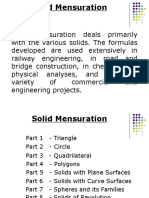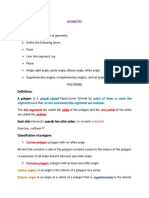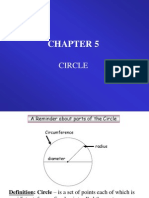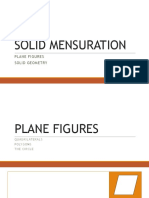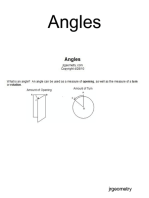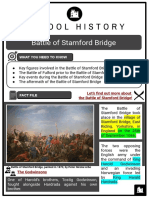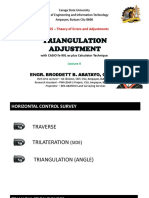NOTES For High Level Math
NOTES For High Level Math
Uploaded by
cloudless_natureCopyright:
Available Formats
NOTES For High Level Math
NOTES For High Level Math
Uploaded by
cloudless_natureOriginal Description:
Original Title
Copyright
Available Formats
Share this document
Did you find this document useful?
Is this content inappropriate?
Copyright:
Available Formats
NOTES For High Level Math
NOTES For High Level Math
Uploaded by
cloudless_natureCopyright:
Available Formats
NOTES: FOR YOU TO KEEP!!!
What is a Polygon? A closed plane figure made up of several line segments that are joined together. The sides do not cross each other. Exactly two sides meet at every vertex. Types of Polygons Regular - all angles are equal and all sides are the same length. Regular polygons are both equiangular and equilateral. Equiangular - all angles are equal. Equilateral - all sides are the same length. Convex - a straight line drawn through a convex polygon crosses at most two sides. Every interior angle is less than 180.
Concave - you can draw at least one straight line through a concave polygon that crosses more than two sides. At least one interior angle is more than 180. Polygon Formulas (N = # of sides and S = length from center to a corner) Area of a regular polygon = (1/2) N sin(360/N) S2 Sum of the interior angles of a polygon = (N - 2) x 180 The number of diagonals in a polygon = 1/2 N(N-3) The number of triangles (when you draw all the diagonals from one vertex) in a polygon = (N - 2) Polygon Parts
Side - one of the line segments that make up the polygon. Vertex - point where two sides meet. Two or more of these points are called vertices. Diagonal - a line connecting two vertices that isn't a side. Interior Angle - Angle formed by two adjacent sides inside the polygon. Exterior Angle - Angle formed by two adjacent sides outside the polygon.
Special Polygons Special Quadrilaterals - square, rhombus, parallelogram, rectangle, and the trapezoid. Special Triangles - right, equilateral, isosceles, scalene, acute, obtuse. Polygon Names Generally accepted names Sides Name n 3 4 N-gon Triangle Quadrilateral
5 6 7 8 10 12
Pentagon Hexagon Heptagon Octagon Decagon Dodecagon
Names for other polygons have been proposed. Sides Name 9 11 13 14 15 16 17 18 19 20 30 40 50 60 70 80 90 100 1,000 Nonagon, Enneagon Undecagon, Hendecagon Tridecagon, Triskaidecagon Tetradecagon, Tetrakaidecagon Pentadecagon, Pentakaidecagon Hexadecagon, Hexakaidecagon Heptadecagon, Heptakaidecagon Octadecagon, Octakaidecagon Enneadecagon, Enneakaidecagon Icosagon Triacontagon Tetracontagon Pentacontagon Hexacontagon Heptacontagon Octacontagon Enneacontagon Hectogon, Hecatontagon Chiliagon
10,000 Myriagon To construct a name, combine the prefix+suffix Sides Prefix 20 30 40 50 60 70 80 90 Icosikai... Triacontakai... Tetracontakai... Pentacontakai... Hexacontakai... Heptacontakai... Octacontakai... Enneacontakai... +
Sides Suffix +1 +2 +3 +4 +5 +6 +7 +8 ...henagon ...digon ...trigon ...tetragon ...pentagon ...hexagon ...heptagon ...octagon
+9
...enneagon
Examples: 46 sided polygon - Tetracontakaihexagon 28 sided polygon - Icosikaioctagon However, many people use the form n-gon, as in 46-gon, or 28-gon instead of these names.
FORMULA REFERENCE SHEET Shape Triangle Rectangle Trapezoid Parallelogram Circle Figure Rectangular Prism Formulas for Volume (V) and Surface Area (SA) V = lwh = length x width x height SA = 2lw + 2hw + 2lh = 2(length x width) + 2(height x width) + 2(length x height) V = Bh = area of base x height SA = sum of the areas of the faces V = Bh = area of base x height SA = 2B + Ch = (2 x area of base) + (circumference x height) Formulas for Area (A) and Circumference (C) A = bh = x base x height
A = lw = length x width A = (b1 + b2)h = x sum of bases x height
A = bh = base x height
General Prisms
Right Circular Cylinder
Square Pyramid Right Circular Cone
Sphere
Equations of a Line Standard Form: Ax + By = C where A and B are not both zero
Coordinate Geometry Formulas Let (x1,y1) and (x2,y2) be two points in the plane.
Slope-Intercept Form:
y = mx + b or y = b + mx where m = slope and b = y-intercept
Point-Slope Formula:
Distance Traveled d = rt distance = rate x time
Polygon Angle Formulas Sum of degree measures of the interior angles of a polygon: 180 (n - 2)
Simple Interest I = prt interest = principal x interest rate x time
Degree measure of an interior angle of a regular polygon:
where n is the number of sides of the polygon Formulas for Right Triangles Special Triangles
You might also like
- Geometry Reference: Points, Lines and Planes CirclesDocument2 pagesGeometry Reference: Points, Lines and Planes Circlesmarko1234No ratings yet
- Kasaysayan 1 - UP DilimanDocument9 pagesKasaysayan 1 - UP Dilimandepachie100% (2)
- Chain of CommandDocument9 pagesChain of CommandGaurav Muteja100% (1)
- Session 5-3: Thailand Case Study by Kraiyos PatrawartDocument30 pagesSession 5-3: Thailand Case Study by Kraiyos PatrawartADBI Events100% (1)
- BABOK 3 - Cheat Sheet - Tasks Vs Guideline and ToolsDocument1 pageBABOK 3 - Cheat Sheet - Tasks Vs Guideline and Toolsprosuman100% (2)
- Geometry HistoryDocument2 pagesGeometry HistoryManilyn Requejo ObalNo ratings yet
- Geometric FormulasDocument7 pagesGeometric Formulasprince168No ratings yet
- PolygonsDocument30 pagesPolygons8-C SHRI SHAASHINI.SNo ratings yet
- Area Formulas: Gemonrty FormulaDocument12 pagesArea Formulas: Gemonrty FormulaPankaj Jirafe100% (1)
- Formula Sheet GeometryDocument2 pagesFormula Sheet Geometrykssuhasreddy_3743947No ratings yet
- Geometry ReviewDocument3 pagesGeometry ReviewJose Luis PiñaNo ratings yet
- Mensuration PDFDocument33 pagesMensuration PDFSudhanshu Kumar100% (1)
- Geometry and TrigonometryDocument6 pagesGeometry and TrigonometryFranc VenturaNo ratings yet
- 271 Mensuration Notes OH1Document32 pages271 Mensuration Notes OH1Joyjoy C LbanezNo ratings yet
- Cliff S Notes GeometryDocument2 pagesCliff S Notes GeometryKamal SharmaNo ratings yet
- Math HelpDocument8 pagesMath Helpatiggy05100% (1)
- MH-CET MBA Geometry FormulaeDocument12 pagesMH-CET MBA Geometry FormulaeNikhil Mahajan100% (1)
- PolygonDocument19 pagesPolygonlhadymhalditah_03100% (1)
- Solid Mensuration - NBCDocument55 pagesSolid Mensuration - NBCsysy67% (6)
- Geometry FlashCardsDocument26 pagesGeometry FlashCardsjcargs3100% (1)
- Geometry: Simple Closed Union of Three or More Line Segments No Two Successive Line Segments Are CollinearDocument15 pagesGeometry: Simple Closed Union of Three or More Line Segments No Two Successive Line Segments Are Collinearzinawbizu filipos100% (1)
- PolygonDocument11 pagesPolygonMd Rizwan AhmadNo ratings yet
- All Math FormulasDocument27 pagesAll Math FormulasMubassher Ahmed Shoaib100% (1)
- CIRCLESDocument5 pagesCIRCLESjainmine2010No ratings yet
- AnglesDocument23 pagesAnglessavsengineering50% (2)
- Geometry and TrigonometryDocument6 pagesGeometry and TrigonometryAbhay SoniNo ratings yet
- Types of PolygonsDocument3 pagesTypes of Polygonsanon-919823100% (9)
- MathematicsDocument10 pagesMathematicsChan Sin LoonNo ratings yet
- Formula Sheet GeometryDocument2 pagesFormula Sheet Geometryessy_abNo ratings yet
- Mathematics 7: School Year 2022-2023Document48 pagesMathematics 7: School Year 2022-2023ハンナジュリーNo ratings yet
- Class 8 NotesDocument40 pagesClass 8 NotesAvantika SNo ratings yet
- Mensuration Formulas For 2D Shapes - VPDocument21 pagesMensuration Formulas For 2D Shapes - VPkrisretro1No ratings yet
- 2 MathDocument5 pages2 MathAlexandra EscalonaNo ratings yet
- Module 4 CircleDocument8 pagesModule 4 CircleasdfghjklNo ratings yet
- Types of Polygons: VertexDocument3 pagesTypes of Polygons: VertexRichard TorzarNo ratings yet
- Ecat MathsDocument7 pagesEcat MathsSAeedNo ratings yet
- Chapter5 CircleDocument34 pagesChapter5 Circlelhadymhalditah_03No ratings yet
- Solid MensurationDocument60 pagesSolid MensurationBenePicar100% (2)
- Geometry FormulasDocument5 pagesGeometry FormulasAlyzza Rose Pampliega LedesmaNo ratings yet
- 0306 Introduction To GeometryDocument16 pages0306 Introduction To GeometryPunitha PanchaNo ratings yet
- TD 1 Geometric ConstructionDocument13 pagesTD 1 Geometric Constructionma.berthiebernadettecasintoNo ratings yet
- Geometry Midterm StudysheetDocument4 pagesGeometry Midterm StudysheetMatt BurkeNo ratings yet
- Solid MensurationDocument28 pagesSolid Mensurationwe_spidus_2006100% (2)
- Formula Sheet GeometryDocument2 pagesFormula Sheet GeometrysamuthrarajaNo ratings yet
- Formula SheetDocument3 pagesFormula SheetShelisa Michaela MuthukumaranaNo ratings yet
- GeometryDocument91 pagesGeometryMichie Muyot100% (1)
- a. Vocabulary and NotationDocument9 pagesa. Vocabulary and NotationMaliha NuzhatNo ratings yet
- Understanding QuadrilateralsDocument68 pagesUnderstanding QuadrilateralsTAMILARASAN ANo ratings yet
- MATH02E Module 5Document28 pagesMATH02E Module 5einahbellissimoNo ratings yet
- Shape Formulas For Area (A) and Circumference (C) : A BH X Base X Height A LW Length X WidthDocument16 pagesShape Formulas For Area (A) and Circumference (C) : A BH X Base X Height A LW Length X WidthDominic G. Casinto100% (1)
- Solid Mensuration - Chapter 1Document76 pagesSolid Mensuration - Chapter 1Christian Esteban80% (10)
- Formula of Various Geometical FiguresDocument10 pagesFormula of Various Geometical FiguresGPrasanna Kumar100% (1)
- Presentation 1Document15 pagesPresentation 1Aditya VermaNo ratings yet
- In Euclidean GeometryDocument32 pagesIn Euclidean GeometryGilar JatisundaNo ratings yet
- For Print FormulaDocument2 pagesFor Print FormulaJaireNo ratings yet
- G7 Ch11 May27Document86 pagesG7 Ch11 May27Zhihui XieNo ratings yet
- Maths-8 U2 Tutorial 2021-2022Document23 pagesMaths-8 U2 Tutorial 2021-2022Tanweer AyoubNo ratings yet
- Practice Makes Perfect in Geometry: Angles, Triangles and other PolygonsFrom EverandPractice Makes Perfect in Geometry: Angles, Triangles and other PolygonsRating: 5 out of 5 stars5/5 (1)
- Origami Dots: Folding paper to explore geometryFrom EverandOrigami Dots: Folding paper to explore geometryRating: 5 out of 5 stars5/5 (1)
- What Happened at The Battle of Stamford Bridge-1Document4 pagesWhat Happened at The Battle of Stamford Bridge-1Annalisa ChenNo ratings yet
- DLL - English 5 - Q1 - W5Document8 pagesDLL - English 5 - Q1 - W5Jessa ValderamaNo ratings yet
- 2021 DCPD Student Guide11 Jun 2021Document233 pages2021 DCPD Student Guide11 Jun 2021Ishwarjit SinghNo ratings yet
- Judicial Misconduct Complaint Motion Under Rule 26Document11 pagesJudicial Misconduct Complaint Motion Under Rule 26EvangelionNo ratings yet
- Project Report Final 1Document116 pagesProject Report Final 1Rushda Anwar ShahidNo ratings yet
- 03 PICMET Keuper Hellwig SubmissionDocument8 pages03 PICMET Keuper Hellwig SubmissionBekir DayiNo ratings yet
- Scared ParentDocument2 pagesScared ParentADHDESCEST100% (1)
- Weekly Quiz Unit 7 Lv12Document4 pagesWeekly Quiz Unit 7 Lv12Phalla OudomNo ratings yet
- El - Habeeb Oum Hanan Book 1Document164 pagesEl - Habeeb Oum Hanan Book 1nabilamalami789No ratings yet
- Between Give and Take - A Clinical Guide To Contextual - Boszormenyi-Nagy, Ivan, 1920-2007 Krasner, Barbara R - , - New York, 1986 - New York - 1134845189 - Anna's ArchiveDocument454 pagesBetween Give and Take - A Clinical Guide To Contextual - Boszormenyi-Nagy, Ivan, 1920-2007 Krasner, Barbara R - , - New York, 1986 - New York - 1134845189 - Anna's ArchiveMilošNo ratings yet
- Sigmund FreudDocument4 pagesSigmund FreudP NjroNo ratings yet
- Electrical Engineering Aptitude PaperDocument3 pagesElectrical Engineering Aptitude PaperAshok SainiNo ratings yet
- Format of Learning Plan in MapehDocument3 pagesFormat of Learning Plan in MapehLen Vicente - Ferrer50% (2)
- Fluid 08Document159 pagesFluid 08Marco MeraNo ratings yet
- English 4am22 2trim1 2Document4 pagesEnglish 4am22 2trim1 2Mouloud RahmaniNo ratings yet
- 21st Century Module 1Document37 pages21st Century Module 1Jem M. Bandaja50% (2)
- Ethics, Business, and Business Ethics ReflectionDocument4 pagesEthics, Business, and Business Ethics ReflectionSandra Mae CabuenasNo ratings yet
- Orchestrating Time: Arrangements of The Brain Circadian ClockDocument7 pagesOrchestrating Time: Arrangements of The Brain Circadian ClockAhmad Haikal Ahmad MochtarNo ratings yet
- GE 105 Lecture 4 (TRIANGULATION ADJUSTMENT) By: Broddett Bello AbatayoDocument20 pagesGE 105 Lecture 4 (TRIANGULATION ADJUSTMENT) By: Broddett Bello AbatayoBroddett Bello Abatayo100% (4)
- Spanish PDFDocument100 pagesSpanish PDFVioly GuianwdNo ratings yet
- 9 Southern Luzon Employees Assn v. GolpeoDocument2 pages9 Southern Luzon Employees Assn v. GolpeoFloyd MagoNo ratings yet
- Only Problems BetaDocument4 pagesOnly Problems BetaSupriya Rane0% (1)
- Ict 9Document5 pagesIct 9OMG WOWNo ratings yet
- Keerthi P: Contact: 832-856-2493Document8 pagesKeerthi P: Contact: 832-856-2493phaniNo ratings yet
- Future Perfect ContinuousDocument4 pagesFuture Perfect ContinuousadauNo ratings yet
- Chapter 2 Strategic Management ProcessDocument52 pagesChapter 2 Strategic Management ProcessAarnesh_Karamc_1764100% (2)


















